Genome-Wide Identification and Expression Analysis of the Walnut C-Repeat Binding Factor Gene Family under Low-Temperature Stress
Abstract
:1. Introduction
2. Results
2.1. Identification and Protein Characterization of JrCBF Genes
2.2. Gene Structure and Conserved Motif Analysis of JrCBF Genes
2.3. Phylogenetic Analysis of the JrCBF Genes
2.4. Cis-Acting Component Analysis in the Promoter of the JrCBF Genes
2.5. Chromosomal Location and Collinearity Analysis of the JrCBF Genes
2.6. Expression Pattern of JrCBF Genes under Low-Temperature Stress
2.7. Expression Patterns of JrCBF Genes under Different Abiotic Stresses
2.8. Subcellular Localization of JrCBF1 and JrCBF2
3. Discussion
4. Materials and Methods
4.1. Genome-Wide Identification of JrCBF Genes in Walnut
4.2. Gene Structure and Phylogenetic Tree
4.3. Identification of Cis-Elements and Collinearity Analysis
4.4. Transcriptional Expression Analysis of Walnut JrCBF Genes
4.5. Expression Pattern of JrCBF Genes under Different Abiotic Stresses
4.6. Subcellular Localisation Analyses
5. Conclusions
Supplementary Materials
Author Contributions
Funding
Data Availability Statement
Conflicts of Interest
References
- Chinnusamy, V.; Zhu, J.; Zhu, J.-K. Cold Stress Regulation of Gene Expression in Plants. Trends Plant Sci. 2007, 12, 444–451. [Google Scholar] [CrossRef] [PubMed]
- Theocharis, A.; Clément, C.; Barka, E.A. Physiological and Molecular Changes in Plants Grown at Low Temperatures. Planta 2012, 235, 1091–1105. [Google Scholar] [CrossRef]
- Doherty, C.J.; Van Buskirk, H.A.; Myers, S.J.; Thomashow, M.F. Roles for Arabidopsis CAMTA Transcription Factors in Cold-Regulated Gene Expression and Freezing Tolerance. Plant Cell 2009, 21, 972–984. [Google Scholar] [CrossRef] [PubMed]
- Zhu, J.; Jeong, J.C.; Zhu, Y.; Sokolchik, I.; Miyazaki, S.; Zhu, J.-K.; Hasegawa, P.M.; Bohnert, H.J.; Shi, H.; Yun, D.-J.; et al. Involvement of Arabidopsis HOS15 in Histone Deacetylation and Cold Tolerance. Proc. Natl. Acad. Sci. USA 2008, 105, 4945–4950. [Google Scholar] [CrossRef] [PubMed]
- Lee, B.; Henderson, D.A.; Zhu, J.-K. The Arabidopsis Cold-Responsive Transcriptome and Its Regulation by ICE1. Plant Cell 2005, 17, 3155–3175. [Google Scholar] [CrossRef]
- Yaish, M.W.F.; Doxey, A.C.; McConkey, B.J.; Moffatt, B.A.; Griffith, M. Cold-Active Winter Rye Glucanases with Ice-Binding Capacity. Plant Physiol. 2006, 141, 1459–1472. [Google Scholar] [CrossRef]
- Sasaki, K.; Kim, M.-H.; Imai, R. Arabidopsis COLD SHOCK DOMAIN PROTEIN2 Is a RNA Chaperone That Is Regulated by Cold and Developmental Signals. Biochem. Biophys. Res. Commun. 2007, 364, 633–638. [Google Scholar] [CrossRef]
- Szabados, L.; Savouré, A. Proline: A Multifunctional Amino Acid. Trends Plant Sci. 2010, 15, 89–97. [Google Scholar] [CrossRef]
- Ruelland, E.; Zachowski, A. How Plants Sense Temperature. Environ. Exp. Bot. 2010, 69, 225–232. [Google Scholar] [CrossRef]
- Solanke, A.U.; Sharma, A.K. Signal Transduction during Cold Stress in Plants. Physiol. Mol. Biol. Plants 2008, 14, 69–79. [Google Scholar] [CrossRef]
- Huang, G.-T.; Ma, S.-L.; Bai, L.-P.; Zhang, L.; Ma, H.; Jia, P.; Liu, J.; Zhong, M.; Guo, Z.-F. Signal Transduction during Cold, Salt, and Drought Stresses in Plants. Mol. Biol. Rep. 2012, 39, 969–987. [Google Scholar] [CrossRef] [PubMed]
- Jiang, Y.; Peng, D.; Bai, L.-P.; Ma, H.; Chen, L.-J.; Zhao, M.-H.; Xu, Z.-J.; Guo, Z.-F. Molecular Switch for Cold Acclimation—Anatomy of the Cold-Inducible Promoter in Plants. Biochemistry 2013, 78, 342–354. [Google Scholar] [CrossRef] [PubMed]
- Guo, J.; Ren, Y.; Tang, Z.; Shi, W.; Zhou, M. Characterization and Expression Profiling of the ICE-CBF-COR Genes in Wheat. PeerJ 2019, 7, e8190. [Google Scholar] [CrossRef] [PubMed]
- Hwarari, D.; Guan, Y.; Ahmad, B.; Movahedi, A.; Min, T.; Hao, Z.; Lu, Y.; Chen, J.; Yang, L. ICE-CBF-COR Signaling Cascade and Its Regulation in Plants Responding to Cold Stress. Int. J. Mol. Sci. 2022, 23, 1549. [Google Scholar] [CrossRef]
- Jin, Y.; Zhai, S.; Wang, W.; Ding, X.; Guo, Z.; Bai, L.; Wang, S. Identification of Genes from the ICE-CBF-COR Pathway under Cold Stress in Aegilops-Triticum Composite Group and the Evolution Analysis with Those from Triticeae. Physiol. Mol. Biol. Plants 2018, 24, 211–229. [Google Scholar] [CrossRef]
- Wang, D.-Z.; Jin, Y.-N.; Ding, X.-H.; Wang, W.-J.; Zhai, S.-S.; Bai, L.-P.; Guo, Z.-F. Gene Regulation and Signal Transduction in the ICE-CBF-COR Signaling Pathway during Cold Stress in Plants. Biochemistry 2017, 82, 1103–1117. [Google Scholar] [CrossRef]
- Maruyama, K.; Takeda, M.; Kidokoro, S.; Yamada, K.; Sakuma, Y.; Urano, K.; Fujita, M.; Yoshiwara, K.; Matsukura, S.; Morishita, Y.; et al. Metabolic Pathways Involved in Cold Acclimation Identified by Integrated Analysis of Metabolites and Transcripts Regulated by DREB1A and DREB2A. Plant Physiol. 2009, 150, 1972–1980. [Google Scholar] [CrossRef]
- Ritonga, F.N.; Chen, S. Physiological and Molecular Mechanism Involved in Cold Stress Tolerance in Plants. Plants 2020, 9, 560. [Google Scholar] [CrossRef]
- Gilmour, S.J.; Zarka, D.G.; Stockinger, E.J.; Salazar, M.P.; Houghton, J.M.; Thomashow, M.F. Low Temperature Regulation of the Arabidopsis CBF Family of AP2 Transcriptional Activators as an Early Step in Cold-Induced COR Gene Expression. Plant J. 1998, 16, 433–442. [Google Scholar] [CrossRef]
- Thomashow, M.F. Molecular Basis of Plant Cold Acclimation: Insights Gained from Studying the CBF Cold Response Pathway. Plant Physiol. 2010, 154, 571–577. [Google Scholar] [CrossRef]
- Haake, V.; Cook, D.; Riechmann, J.L.; Pineda, O.; Thomashow, M.F.; Zhang, J.Z. Transcription Factor CBF4 Is a Regulator of Drought Adaptation in Arabidopsis. Plant Physiol. 2002, 130, 639–648. [Google Scholar] [CrossRef] [PubMed]
- Magome, H.; Yamaguchi, S.; Hanada, A.; Kamiya, Y.; Oda, K. Dwarf and Delayed-Flowering 1, a Novel Arabidopsis Mutant Deficient in Gibberellin Biosynthesis Because of Overexpression of a Putative AP2 Transcription Factor. Plant J. 2004, 37, 720–729. [Google Scholar] [CrossRef] [PubMed]
- Liu, Q.; Kasuga, M.; Sakuma, Y.; Abe, H.; Miura, S.; Yamaguchi-Shinozaki, K.; Shinozaki, K. Two Transcription Factors, DREB1 and DREB2, with an EREBP/AP2 DNA Binding Domain Separate Two Cellular Signal Transduction Pathways in Drought- and Low-Temperature-Responsive Gene Expression, Respectively, in Arabidopsis. Plant Cell 1998, 10, 1391–1406. [Google Scholar] [CrossRef] [PubMed]
- Medina, J.; Bargues, M.; Terol, J.; Pérez-Alonso, M.; Salinas, J. The Arabidopsis CBF Gene Family Is Composed of Three Genes Encoding AP2 Domain-Containing Proteins Whose Expression Is Regulated by Low Temperature but Not by Abscisic Acid or Dehydration. Plant Physiol. 1999, 119, 463–470. [Google Scholar] [CrossRef]
- Gilmour, S.J.; Sebolt, A.M.; Salazar, M.P.; Everard, J.D.; Thomashow, M.F. Overexpression of the Arabidopsis CBF3 Transcriptional Activator Mimics Multiple Biochemical Changes Associated with Cold Acclimation. Plant Physiol. 2000, 124, 1854–1865. [Google Scholar] [CrossRef]
- Hao, G.-P.; Wu, Z.-Y.; Cao, M.-Q.; Pelletier, G.; Brunel, D.; Huang, C.-L.; Yang, Q. Nucleotide polymorphism in the drought induced transcription factor CBF4 region of Arabidopsis thaliana and its molecular evolution analyses. Yi Chuan Xue Bao 2004, 31, 1415–1425. [Google Scholar]
- Magome, H.; Yamaguchi, S.; Hanada, A.; Kamiya, Y.; Oda, K. The DDF1 Transcriptional Activator Upregulates Expression of a Gibberellin-Deactivating Gene, GA2ox7, under High-Salinity Stress in Arabidopsis. Plant J. 2008, 56, 613–626. [Google Scholar] [CrossRef]
- Zhao, K.; Zhou, Y.; Li, Y.; Zhuo, X.; Ahmad, S.; Han, Y.; Yong, X.; Zhang, Q. Crosstalk of PmCBFs and PmDAMs Based on the Changes of Phytohormones under Seasonal Cold Stress in the Stem of Prunus Mume. Int. J. Mol. Sci. 2018, 19, 15. [Google Scholar] [CrossRef]
- Li, J.; Zheng, G.; Li, S.; Tang, Z.; Sun, J.; Xin, X. Characterization of Rosa Chinensis CBF Genes and the Function of RcCBF6 in Cold Tolerance. J. Plant Biol. 2020, 63, 267–278. [Google Scholar] [CrossRef]
- Panchy, N.; Lehti-Shiu, M.; Shiu, S.-H. Evolution of Gene Duplication in Plants. Plant Physiol. 2016, 171, 2294–2316. [Google Scholar] [CrossRef]
- Martínez, M.L.; Mattea, M.A.; Maestri, D.M. Pressing and Supercritical Carbon Dioxide Extraction of Walnut Oil. J. Food Eng. 2008, 88, 399–404. [Google Scholar] [CrossRef]
- Jia, Y.; Ding, Y.; Shi, Y.; Zhang, X.; Gong, Z.; Yang, S. The Cbfs Triple Mutants Reveal the Essential Functions of CBFs in Cold Acclimation and Allow the Definition of CBF Regulons in Arabidopsis. New Phytol. 2016, 212, 345–353. [Google Scholar] [CrossRef] [PubMed]
- Zhao, C.; Zhang, Z.; Xie, S.; Si, T.; Li, Y.; Zhu, J.-K. Mutational Evidence for the Critical Role of CBF Transcription Factors in Cold Acclimation in Arabidopsis. Plant Physiol. 2016, 171, 2744–2759. [Google Scholar] [CrossRef] [PubMed]
- Zhang, X.; Yu, J.; Wang, R.; Liu, W.; Chen, S.; Wang, Y.; Yu, Y.; Qu, G.; Chen, S. Genome-Wide Identification and Expression Profiles of C-Repeat Binding Factor Transcription Factors in Betula Platyphylla under Abiotic Stress. Int. J. Mol. Sci. 2023, 24, 10573. [Google Scholar] [CrossRef]
- Li, J.; Li, H.; Quan, X.; Shan, Q.; Wang, W.; Yin, N.; Wang, S.; Wang, Z.; He, W. Comprehensive Analysis of Cucumber C-Repeat/Dehydration-Responsive Element Binding Factor Family Genes and Their Potential Roles in Cold Tolerance of Cucumber. BMC Plant Biol. 2022, 22, 270. [Google Scholar] [CrossRef]
- Guan, Y.; Liu, S.; Wu, W.; Hong, K.; Li, R.; Zhu, L.; Liu, Y.; Lu, Y.; Chen, J.; Yang, L.; et al. Genome-Wide Identification and Cold Stress-Induced Expression Analysis of the CBF Gene Family in Liriodendron chinense. J. For. Res. 2021, 32, 2531–2543. [Google Scholar] [CrossRef]
- Liu, H.; Lyu, H.-M.; Zhu, K.; Van de Peer, Y.; Max Cheng, Z.-M. The Emergence and Evolution of Intron-Poor and Intronless Genes in Intron-Rich Plant Gene Families. Plant J. 2021, 105, 1072–1082. [Google Scholar] [CrossRef]
- Sakuma, Y.; Liu, Q.; Dubouzet, J.G.; Abe, H.; Shinozaki, K.; Yamaguchi-Shinozaki, K. DNA-Binding Specificity of the ERF/AP2 Domain of Arabidopsis DREBs, Transcription Factors Involved in Dehydration- and Cold-Inducible Gene Expression. Biochem. Biophys. Res. Commun. 2002, 290, 998–1009. [Google Scholar] [CrossRef]
- Canella, D.; Gilmour, S.J.; Kuhn, L.A.; Thomashow, M.F. DNA Binding by the Arabidopsis CBF1 Transcription Factor Requires the PKKP/RAGRxKFxETRHP Signature Sequence. Biochim. Biophys. Acta 2010, 1799, 454–462. [Google Scholar] [CrossRef]
- Qiu, X.; Sun, G.; Liu, F.; Hu, W. Functions of Plant Phytochrome Signaling Pathways in Adaptation to Diverse Stresses. Int. J. Mol. Sci. 2023, 24, 13201. [Google Scholar] [CrossRef]
- Lee, C.-M.; Thomashow, M.F. Photoperiodic Regulation of the C-Repeat Binding Factor (CBF) Cold Acclimation Pathway and Freezing Tolerance in Arabidopsis Thaliana. Proc. Natl. Acad. Sci. USA 2012, 109, 15054–15059. [Google Scholar] [CrossRef] [PubMed]
- Mustilli, A.-C.; Merlot, S.; Vavasseur, A.; Fenzi, F.; Giraudat, J. Arabidopsis OST1 Protein Kinase Mediates the Regulation of Stomatal Aperture by Abscisic Acid and Acts Upstream of Reactive Oxygen Species Production. Plant Cell 2002, 14, 3089–3099. [Google Scholar] [CrossRef] [PubMed]
- Lee, H.G.; Seo, P.J. The MYB96-HHP Module Integrates Cold and Abscisic Acid Signaling to Activate the CBF-COR Pathway in Arabidopsis. Plant J. 2015, 82, 962–977. [Google Scholar] [CrossRef] [PubMed]
- Lee, S.-C.; Lim, M.-H.; Yu, J.-G.; Park, B.-S.; Yang, T.-J. Genome-Wide Characterization of the CBF/DREB1 Gene Family in Brassica Rapa. Plant Physiol. Biochem. 2012, 61, 142–152. [Google Scholar] [CrossRef]
- Zhao, Q.; Han, R.; Cai, K.; Yan, H.; Li, Y.; Qu, G.; Liu, L.; Zhao, X. Identification and Analysis of the CBF Gene Family in Three Species of Acer under Cold Stress. Int. J. Mol. Sci. 2023, 24, 2088. [Google Scholar] [CrossRef]
- Zhang, H.; Gong, Y.; Sun, P.; Chen, S.; Ma, C. Genome-Wide Identification of CBF Genes and Their Responses to Cold Acclimation in Taraxacum Kok-Saghyz. PeerJ 2022, 10, e13429. [Google Scholar] [CrossRef]
- Wang, D.; Cui, B.; Guo, H.; Liu, Y.; Nie, S. Genome-Wide Identification and Expression Analysis of the CBF Transcription Factor Family in Lolium perenne under Abiotic Stress. Plant Signal Behav. 2022, 17, 2086733. [Google Scholar] [CrossRef]
- Wang, J.; Marowsky, N.C.; Fan, C. Divergent Evolutionary and Expression Patterns between Lineage Specific New Duplicate Genes and Their Parental Paralogs in Arabidopsis Thaliana. PLoS ONE 2013, 8, e72362. [Google Scholar] [CrossRef]
- Hill, M.S.; Vande Zande, P.; Wittkopp, P.J. Molecular and Evolutionary Processes Generating Variation in Gene Expression. Nat. Rev. Genet. 2021, 22, 203–215. [Google Scholar] [CrossRef]
- Hu, Z.; Ban, Q.; Hao, J.; Zhu, X.; Cheng, Y.; Mao, J.; Lin, M.; Xia, E.; Li, Y. Genome-Wide Characterization of the C-Repeat Binding Factor (CBF) Gene Family Involved in the Response to Abiotic Stresses in Tea Plant (Camellia sinensis). Front. Plant Sci. 2020, 11, 921. [Google Scholar] [CrossRef]
- Li, W.; Chen, Y.; Ye, M.; Lu, H.; Wang, D.; Chen, Q. Evolutionary History of the C-Repeat Binding Factor/Dehydration-Responsive Element-Binding 1 (CBF/DREB1) Protein Family in 43 Plant Species and Characterization of CBF/DREB1 Proteins in Solanum tuberosum. BMC Evol. Biol. 2020, 20, 142. [Google Scholar] [CrossRef] [PubMed]
- Park, S.; Shi, A.; Mou, B. Genome-Wide Identification and Expression Analysis of the CBF/DREB1 Gene Family in Lettuce. Sci. Rep. 2020, 10, 5733. [Google Scholar] [CrossRef] [PubMed]
- Bailey, T.L.; Boden, M.; Buske, F.A.; Frith, M.; Grant, C.E.; Clementi, L.; Ren, J.; Li, W.W.; Noble, W.S. MEME SUITE: Tools for Motif Discovery and Searching. Nucleic Acids Res. 2009, 37, W202–W208. [Google Scholar] [CrossRef] [PubMed]
- Larkin, M.A.; Blackshields, G.; Brown, N.P.; Chenna, R.; McGettigan, P.A.; McWilliam, H.; Valentin, F.; Wallace, I.M.; Wilm, A.; Lopez, R.; et al. Clustal W and Clustal X Version 2.0. Bioinformatics 2007, 23, 2947–2948. [Google Scholar] [CrossRef] [PubMed]
- Wang, Y.; Tang, H.; DeBarry, J.D.; Tan, X.; Li, J.; Wang, X.; Lee, T.; Jin, H.; Marler, B.; Guo, H.; et al. MCScanX: A Toolkit for Detection and Evolutionary Analysis of Gene Synteny and Collinearity. Nucleic Acids Res. 2012, 40, e49. [Google Scholar] [CrossRef] [PubMed]
- Liang, H.; Zhou, W.; Landweber, L.F. SWAKK: A Web Server for Detecting Positive Selection in Proteins Using a Sliding Window Substitution Rate Analysis. Nucleic Acids Res. 2006, 34, W382–W384. [Google Scholar] [CrossRef]
- Wang, Q.; Zhang, X.; Lin, S.; Yang, S.; Yan, X.; Bendahmane, M.; Bao, M.; Fu, X. Mapping a Double Flower Phenotype-Associated Gene DcAP2L in Dianthus chinensis. J. Exp. Bot. 2020, 71, 1915–1927. [Google Scholar] [CrossRef]
- Song, F.; Li, Z.; Wang, C.; Jiang, Y.; Wang, Z.; He, L.; Ma, X.; Zhang, Y.; Song, X.; Liu, J.; et al. CsMYB15 Positively Regulates Cs4CL2-Mediated Lignin Biosynthesis during Juice Sac Granulation in Navel Orange. Front. Plant Sci. 2023, 14, 1223820. [Google Scholar] [CrossRef]
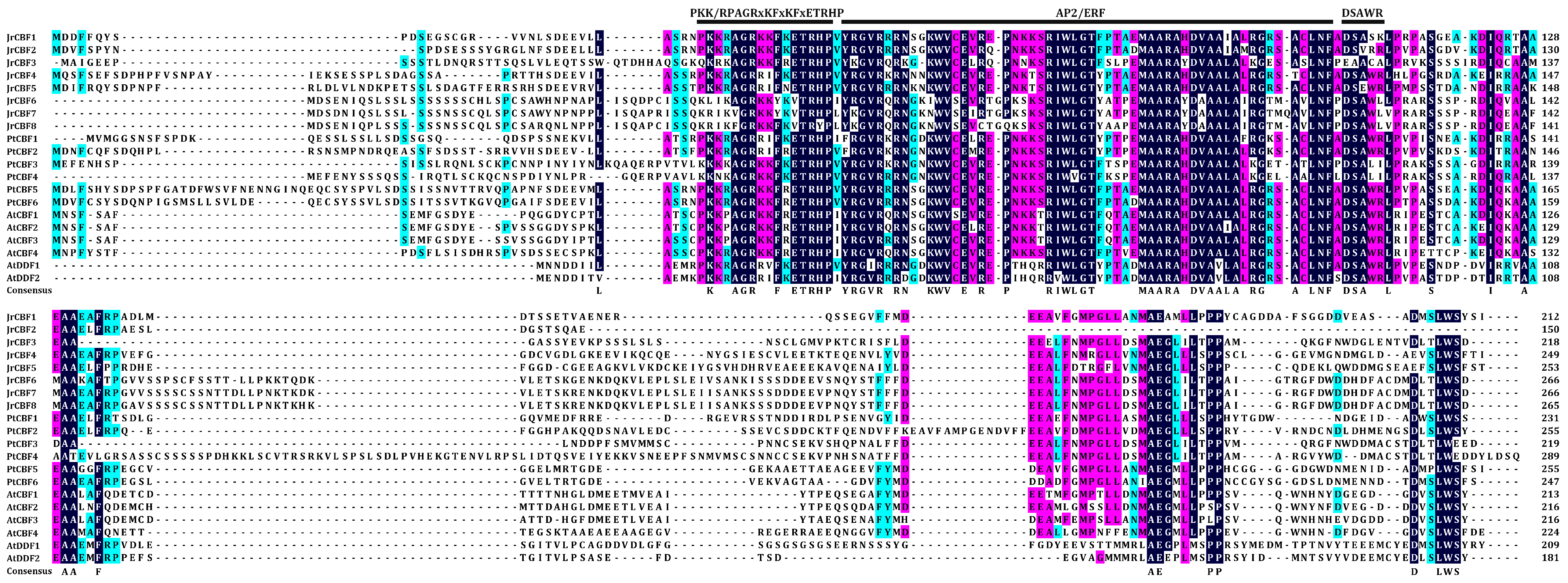
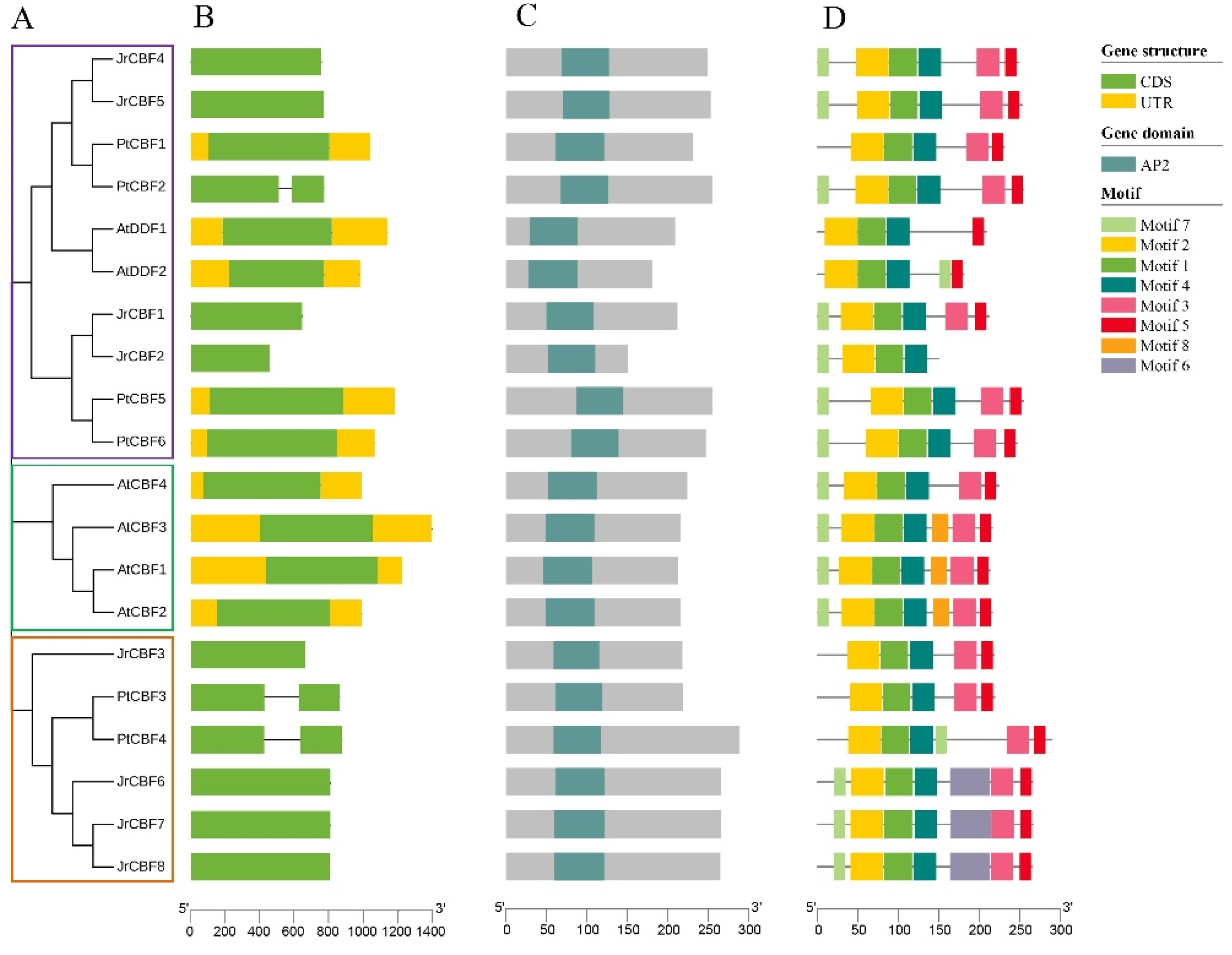


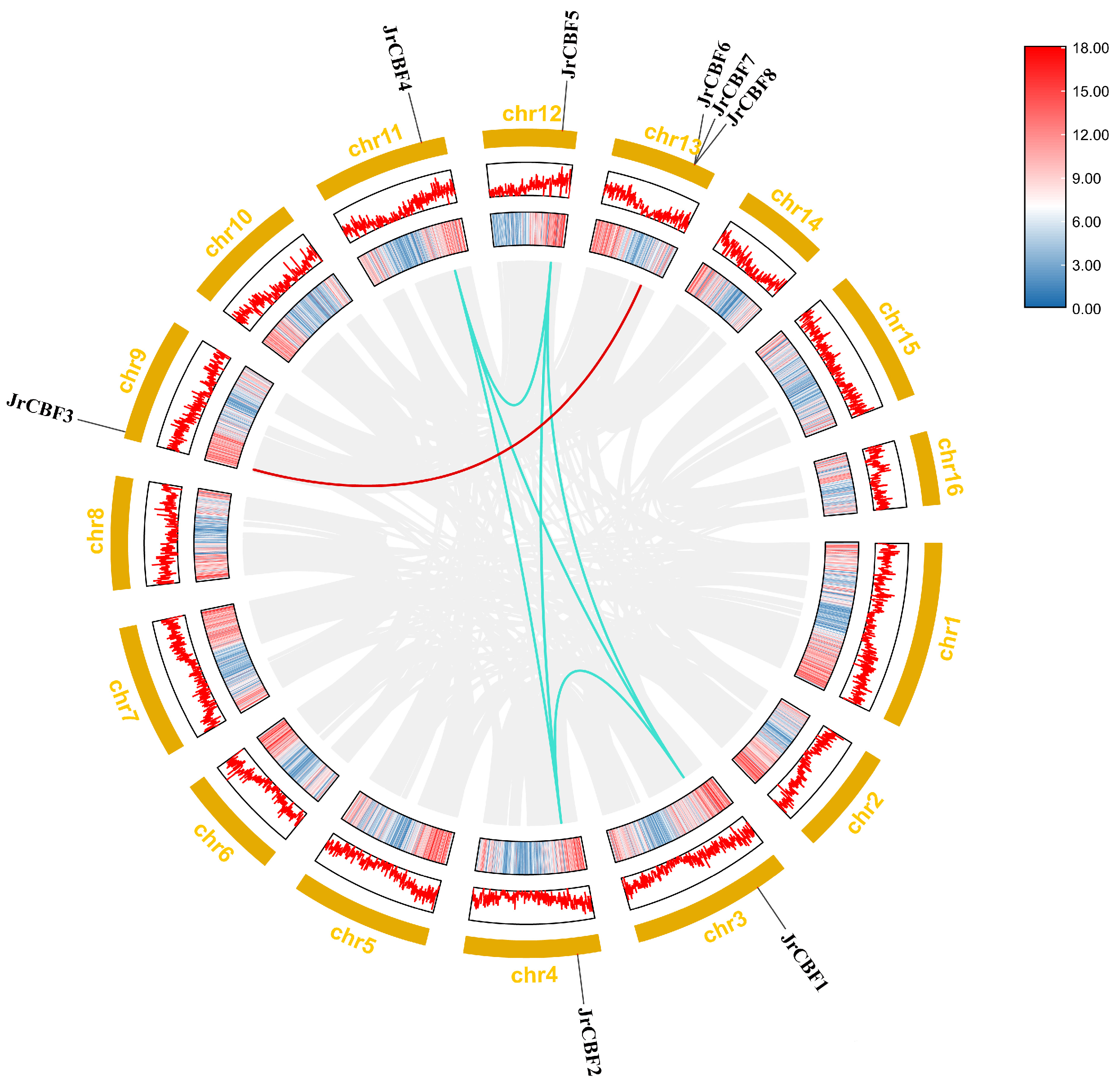

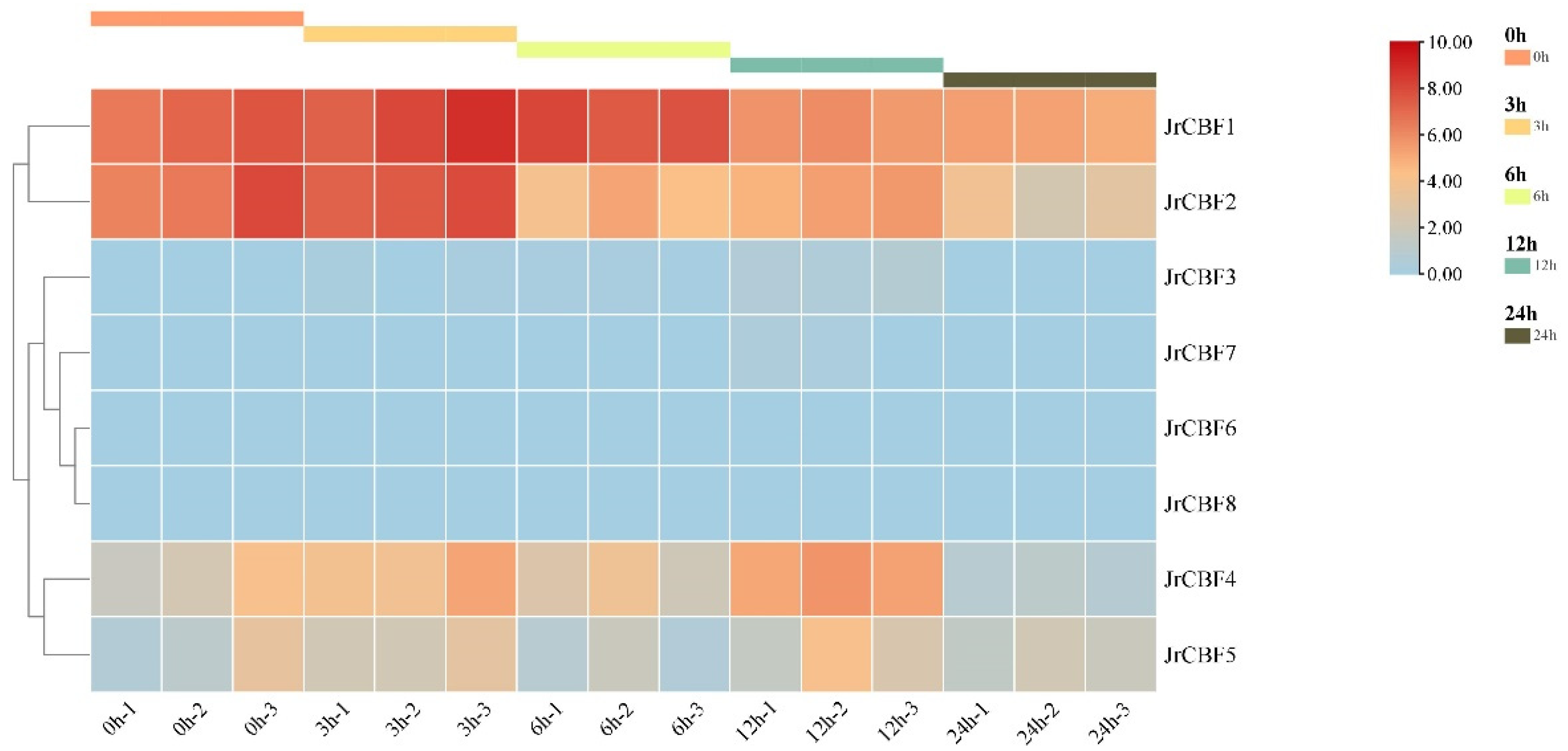
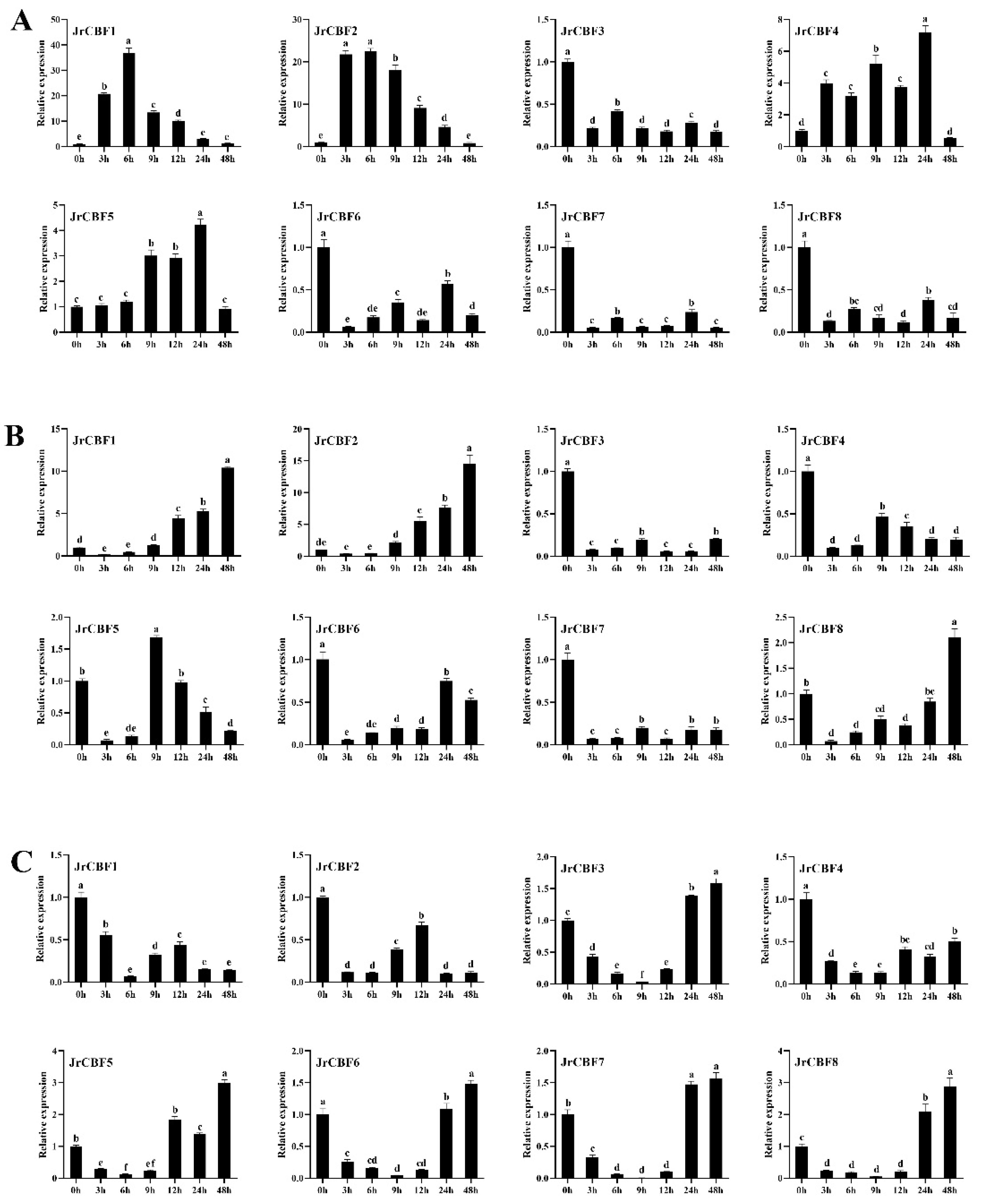
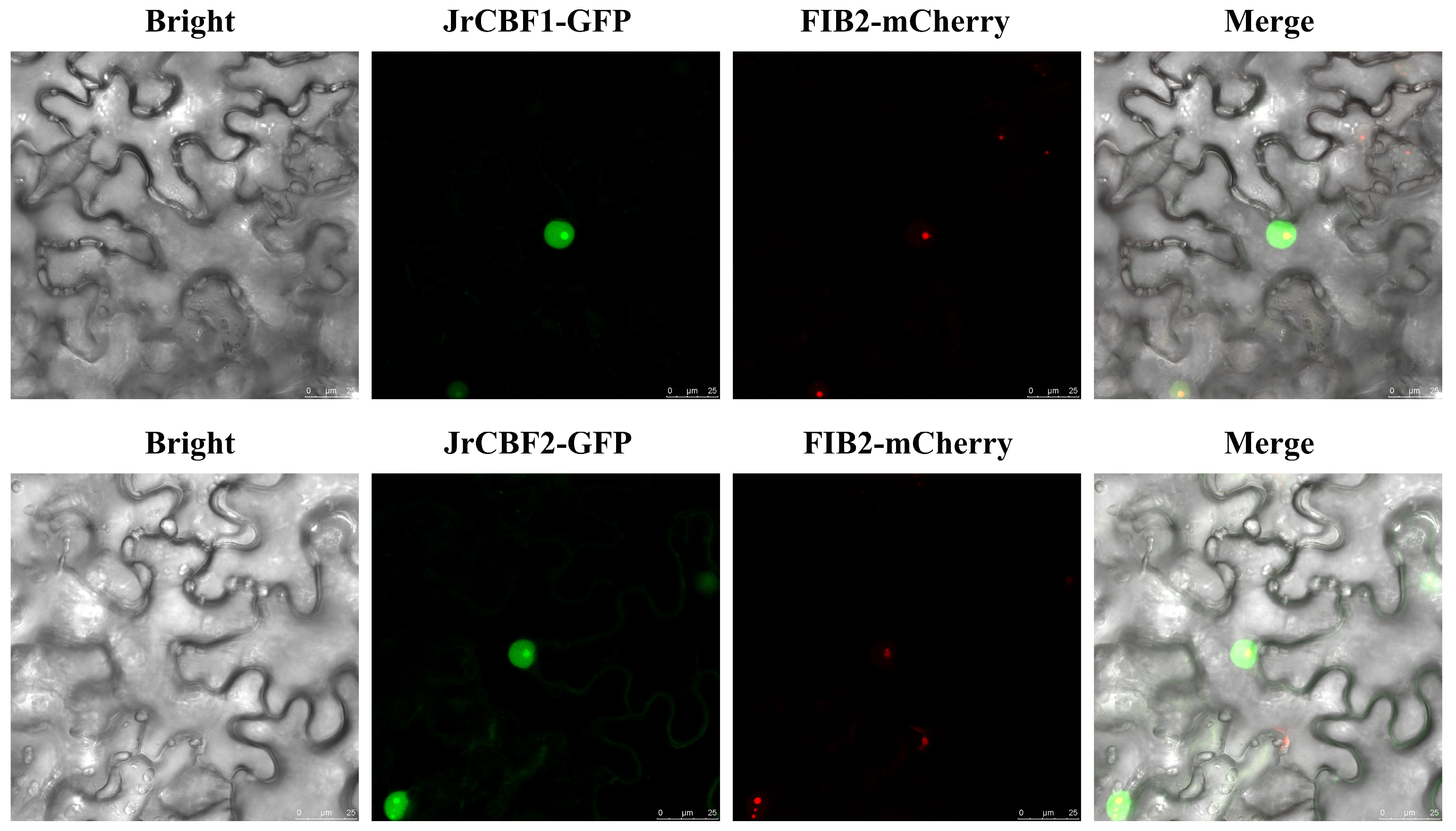
| Gene Name | Gene ID | Protein Length (aa) | MW (kD) | pI | GRAVY | Instability Index | Predicted Location |
|---|---|---|---|---|---|---|---|
| JrCBF1 | JreChr03G13399 | 212 | 23.25 | 5.26 | −0.563 | 52.72 | Nucleus |
| JrCBF2 | JreChr04G12265 | 150 | 16.68 | 10.00 | −0.744 | 59.52 | Nucleus |
| JrCBF3 | JreChr09G12450 | 218 | 24.00 | 8.59 | −0.477 | 54.02 | Nucleus |
| JrCBF4 | JreChr11G11425 | 249 | 27.63 | 5.53 | −0.482 | 57.99 | Nucleus |
| JrCBF5 | JreChr12G11046 | 253 | 28.82 | 5.42 | −0.743 | 56.81 | Nucleus |
| JrCBF6 | JreChr13G10824 | 266 | 29.15 | 6.44 | −0.331 | 56.14 | Nucleus |
| JrCBF7 | JreChr13G10825 | 266 | 29.45 | 5.82 | −0.512 | 55.73 | Nucleus |
| JrCBF8 | JreChr13G10826 | 265 | 29.46 | 6.19 | −0.486 | 60.50 | Nucleus |
Disclaimer/Publisher’s Note: The statements, opinions and data contained in all publications are solely those of the individual author(s) and contributor(s) and not of MDPI and/or the editor(s). MDPI and/or the editor(s) disclaim responsibility for any injury to people or property resulting from any ideas, methods, instructions or products referred to in the content. |
© 2023 by the authors. Licensee MDPI, Basel, Switzerland. This article is an open access article distributed under the terms and conditions of the Creative Commons Attribution (CC BY) license (https://creativecommons.org/licenses/by/4.0/).
Share and Cite
Liu, N.; Du, H.; Xue, Y.; Liao, Y.; Zhang, W.; Ye, J.; Wang, Q.; Xu, F. Genome-Wide Identification and Expression Analysis of the Walnut C-Repeat Binding Factor Gene Family under Low-Temperature Stress. Forests 2023, 14, 2274. https://doi.org/10.3390/f14112274
Liu N, Du H, Xue Y, Liao Y, Zhang W, Ye J, Wang Q, Xu F. Genome-Wide Identification and Expression Analysis of the Walnut C-Repeat Binding Factor Gene Family under Low-Temperature Stress. Forests. 2023; 14(11):2274. https://doi.org/10.3390/f14112274
Chicago/Turabian StyleLiu, Ningfang, Hao Du, Yansheng Xue, Yongling Liao, Weiwei Zhang, Jiabao Ye, Qijian Wang, and Feng Xu. 2023. "Genome-Wide Identification and Expression Analysis of the Walnut C-Repeat Binding Factor Gene Family under Low-Temperature Stress" Forests 14, no. 11: 2274. https://doi.org/10.3390/f14112274
APA StyleLiu, N., Du, H., Xue, Y., Liao, Y., Zhang, W., Ye, J., Wang, Q., & Xu, F. (2023). Genome-Wide Identification and Expression Analysis of the Walnut C-Repeat Binding Factor Gene Family under Low-Temperature Stress. Forests, 14(11), 2274. https://doi.org/10.3390/f14112274





